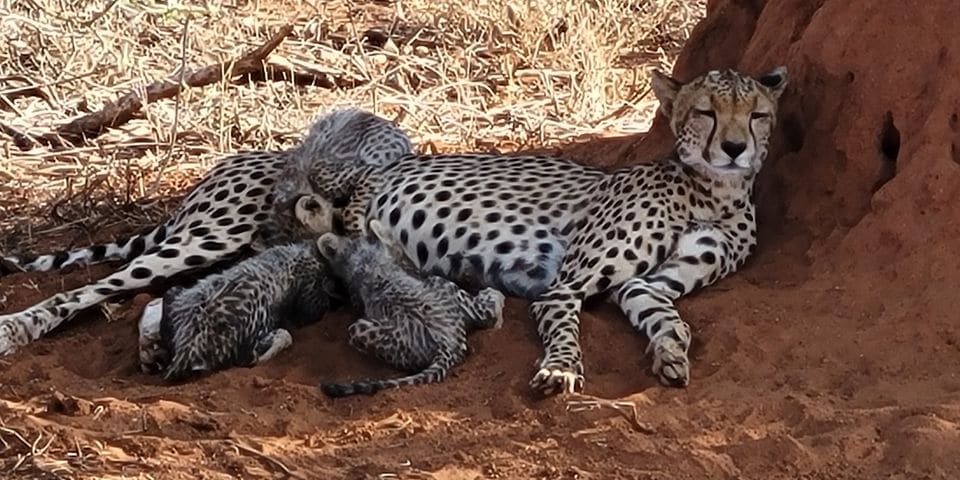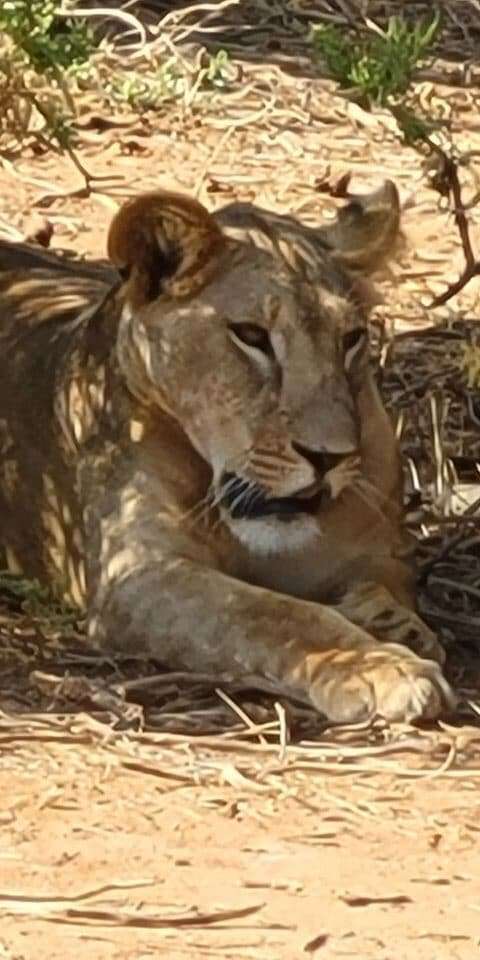Within minutes of entering the main gate at Archer’s Post, Julius Lesori,our Samburu driver-guide asks the group of women on safari with Girls Guide to Paris & Beyond, “Which is your favourite animal?”
He’s got a twinkle in his eye, waiting for that answer to make a wish come true.
The women respond with a magnitude of Africa’s animals: elephants, lion, leopard, giraffe…until one lady goes: “Cheetah…I want to see cheetahs.”

In the next few minutes of Samburu’s savannah-filled heat-resilient thorny acacias, commiphoras and the pink-flowered radiant Desert Rose, Julius meanders the safari cruiser to a standstill. Camouflaged against the earthy soil under a scrawny acacia is the spotted sphinx and her four fluff balls. We draw our breath in, to be in the presence of one of the big cats – and one that is increasingly on the decline – the cheetah.
The feline is resting but her topaz eyes alert. Her month-old cubs suck on her teats, chase each other, climb on her but never wander away. We are alone with her. Behind her, a kilometre away is the river on whose bank is our abode for the night, Elephant Bedroom Camp.
It’s November and the short rains in the northern drylands are late. The grass is parched and the Ewaso Nyiro, that is the life-lung of this arid land, a thin shallow flow, her banks glistening with sand. But she is the magnet that attracts the creatures of the wild to her shores to quench their thirst.

Mary Wykstra of Action for Cheetahs in Kenya (ACK not to be confused with the church) gives an insight to the spotted sphinx in today’s rapidly changing world. “The Laikipia, Samburu, Isiolo, Meru regions are the largest area of connected cheetah population within Kenya,” tells the scientist studying cheetahs outside protected areas.
According to the cheetah woman, these cats share space with people. In Kenya which is a cheetah stronghold, almost 80 percent live outside of the protected areas. That cheetahs are declining at a rate of 2.1 percent annually across their range means that we have to be smart about conserving the last of the wild.
It’s possible according to the cheetah scientist. “If the government and NGOs work together, using science and technology to plan development that includes underpasses, overpasses, considers wildlife and livestock migratory routes, and at the same time provide all that is needed to bring infrastructure to rural communities.”
Despite the drought, our game drives are exciting. The lions snooze in the bushes, a pair of Silver-backed Jackals has hunted a dikdik, and herds of elephants coated in red dust file past us, gingerly kicking the remaining straws of grass loose with their mighty feet, to put into their mouths with their long trunks. A playful calf oblivious of the drought, imitates the older elephants, kicking clumps of dry grass but almost trips. Then the baby has a go with its trunk at picking the grass off the ground and twirling it to its mouth. The grass falls. Unperturbed, the calf finds this a playful venture knowing that the mother is close when it wants to suckle.
Like human babies, elephant babies also need to practice coordination.
Samburu’s wildlife is spectacular, the reserve a microcosm for the wildlife. The handsome Beisa oryx with long, sharp horns and a beautiful patterned face that resemble a pharaoh’s mask graze in the higher hills of ancient stone in the wake of Ol Lolokwe, the sacred mountain of the Samburu. Fine stripes appear.
It’s a herd of grevy’s zebra, now increasingly rare like the spotted sphinx. With only 3,000 Grevy’s zebra left in the wild, Sheila Funnel of Grevy’s Zebra Trust accompanying us talks about the work of GTZ. “We are the only organisation that is 100 percent dedicated to Grevy’s zebra conservation in Kenya,” she states.
The corner stone of GTZ’s work is partnering with the pastoralist communities living alongside the Grevy’s zebra with projects like regenerating grasslands vital for both livestock and the rare equid.
Between exciting game drives at sunrise and sunset to catch the magical golden light, there’s diva time for sumptuous dining and invigorating massages in the sensual space that is Samburu.
Safari to Samburu
320 kilometres of Nairobi, you can either fly or drive. The upmarket Elephant Bedroom Camp is on the banks of the Ewaso Nyiro, with elephants browsing around.
Read up on the work of the wildlife conservation organisations or make a donation to help them to continue.
Credit: Source link